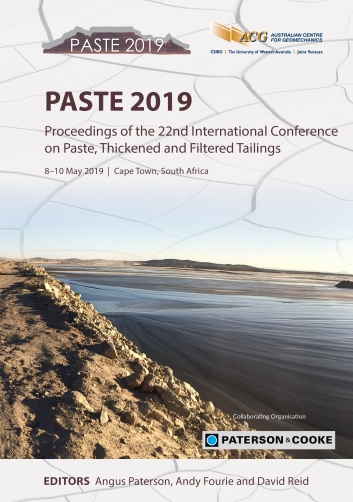Mine fines dewatering trials using amphibious vehicles at the Tronox KZN Sands Fairbreeze Mine

|
Authors: Cocks, BLD |
DOI https://doi.org/10.36487/ACG_rep/1910_36_Cocks
Cite As:
Cocks, BLD 2019, 'Mine fines dewatering trials using amphibious vehicles at the Tronox KZN Sands Fairbreeze Mine', in AJC Paterson, AB Fourie & D Reid (eds), Paste 2019: Proceedings of the 22nd International Conference on Paste, Thickened and Filtered Tailings, Australian Centre for Geomechanics, Perth, pp. 479-491, https://doi.org/10.36487/ACG_rep/1910_36_Cocks
Abstract:
The Tronox KZN Sands Fairbreeze Mine is located in Zululand, south of Mtunzini on the east coast of South Africa. Mining activities commenced in 2015 and the declared life of the mine is 15 years. Fairbreeze Mine is beneficiating an orebody that is part of the Berea Red dune system and the fines content is known to approach 30% in some areas of the deposit. The definition of ‘fines’ in the mineral sands industry is classified as any particle passing 75 µm and consists predominantly of clays and some traces of silica particles of silt size. Historically, the mining industry has made use of sub-aerial deposition to dewater fines that do not drain freely. The only tools available to the processing facilities using the sub-aerial deposition dewatering method, has been: In order to minimise the risk and to reduce the sterilisation of large tracts of land, mining companies are being forced to consider alternative dewatering techniques. The use of amphibious vehicles, or mud-crawlers, is a well-documented alternative in the alumina industry but little is known about the performance of amphibious scrollers on mineral sands fines residue. This paper investigates the effects of mechanical scrolling performed by mud-crawlers on the dewatering and the ultimate final dry density of Fairbreeze fines. The investigation looks at ways that mud-crawlers can be applied as a financially viable alternative to sub-aerial deposition.
Keywords: amphibious vehicle, mud-crawler, bleed, fines, disposal, residue, dewatering, sub-aerial deposition, mud-crawler, ridge, scroll, mineral sands
References:
Feng, Y & Yang, C 2010, ‘Deep foundations and geotechnical in situ testing’, Proceedings of GeoShanghai International Conference, American Society of Civil Engineers, Reston.
Li, H, Amghar, M & Syme, D 2014, ‘Field farming trials of bauxite residue’, in R Jewell, A Fourie, P Swells & D van Zyl (eds), Proceedings of the 17th International Seminar on Paste and Thickened Tailings, InfoMine, Vancouver, pp. 394–402.
Munro, L & Smirk, D 2012, ‘Optimising bauxite residue deliquoring and consolidation’, Proceedings of the Alumina Quality Workshop AQW2012.
Phibion 2018, Case Study: Tailings Management – Phosphate, Phibion Pty Ltd, viewed 26 November 2018,
Poulos, SJ, Robinsky, EI & Keller, TO 1985, ‘Liquefaction resistance of thickened tailings,’ Journal of Geotechnical Engineering, vol. III, no. 12.
Ribeiro, DV, Labrincha, JA & Morelli, MR 2011, ‘Potential use of natural red mud as pozzolan for Portland Cement’, Materials Research, vol. 14, no. 1, pp. 60–66.
© Copyright 2025, Australian Centre for Geomechanics (ACG), The University of Western Australia. All rights reserved.
View copyright/legal information
Please direct any queries or error reports to repository-acg@uwa.edu.au
View copyright/legal information
Please direct any queries or error reports to repository-acg@uwa.edu.au


